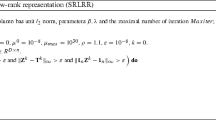Abstract
In the real world, data samples are often contaminated. Using these contaminated data samples for subspace segmentation usually leads to segmentation results distorted. To remove error, many existing subspace segmentation algorithms directly use different regularization to model the error of the corresponding type in the objective. However, the priori of errors is difficult to obtain in practice, which leads to the degradation of segmentation performance. In this work, we propose to jointly learn the representation matrix and eliminate the effect of errors in the low rank projection spaces via joint the nuclear norm and \(\ell _{21} \)-norm minimization on the representation matrix for subspace segmentation, termed as robust low rank subspace segmentation via joint \(\ell _{21} \)-norm minimization (LR-L21). Numerical experiments indicate that the proposed method can effectively deal with different types of errors possibly existing in data, even without the priori of errors. A simple and efficient algorithm is presented based on the alternating direction method, which is convergent. Extensive experiments on three real datasets demonstrate the effectiveness of the proposed approach.




Similar content being viewed by others
Explore related subjects
Discover the latest articles and news from researchers in related subjects, suggested using machine learning.References
Georghiades AS, Belhumeur PN, Kriegman DJ (2001) From few to many: illumination cone models for face recognition under variable lighting and pose. IEEE Trans Pattern Anal Mach Intell 23:643–660
Tron R, Vidal R (2007) A benchmark for the comparison of 3-d motion segmentation algorithms. In: CVPR
Smith CM, Finger JH, Hayamizu TF, McCright IJ, Eppig JT, Kadin JA, Richardson JE, Ringwald M (2007) The mouse gene expression database (GXD): 2007 update. Nucleic Acids Res 35(Database issue):D618–D623
Agrawal R, Gehrke J, Gunopulos D, Raghavan P (2005) Automatic subspace clustering of high dimensional data. Data Min Knowl Discov 11:5–33
Ng A, Weiss Y, Jordan M (2001) On spectral clustering: analysis and an algorithm. In: Neural information processing systems, pp 849–856
Zelnik-Manor L, Irani M (2003) Degeneracies, dependencies and their implications in multi-body and multi-sequence factorization. In: CVPR
Yan J, Pollefeys M (2006) A general framework for motion segmentation: Independent, articulated, rigid, non-rigid, degenerate and non-degenerate. In: European conference on computer vision, pp 94–106
Chen G, Lerman G (2009) Spectral curvature clustering (SCC). Int J Comput Vis 81:317–330
Lu CY, Min H, Zhao ZQ, Zhu L, Huang DS, Yan S (2012) Robust and efficient subspace segmentation via least squares regression. In: IEEE computer vision, pp 347–360
Liu G, Lin Z, Yan S, Sun J, Yu Y, Ma Y (2013) Robust recovery of subspace structures by low-rank representation. IEEE Trans Pattern Anal Mach Intell 35:171–184
Vidal R, Favaro P (2014) Low rank subspace clustering. IEEE Pattern Recognit Lett 43:47–61
Elhamifar E, Vidal R (2013) Sparse subspace clustering: algorithm, theory, and applications. IEEE Tran Pattern Anal Mach Intell 35:2765–2781
Rao S, Tron R, Vidal R, Ma Y (2010) Motion segmentation in the presence of outlying, incomplete, or corrupted trajectories. IEEE Trans Pattern Anal Mach Intell 32:1832–1845
Candes E, Plan Y (2010) Matrix completion with noise. IEEE 98:925–936
Candés E, Li X, Ma Y, Wright J (2011) Robust principal component analysis. In: ACM, p 5811
Xu H, Caramanis C, Sanghavi S (2010) Robust PCA via outlier pursuit. Syst Adv Neural Inf Process Syst 23:2496–2504
Lin Z, Liu R, Su Z (2011) Linearized alternating direction method with adaptive penalty for low-rank representation. In: Advances in neural information processing systems, pp 612–620
Li F-F, Fergus R, Perona P (2004) Learning generative visual models from few training examples: an incremental bayesian approach tested on 101 object categories. In: CVPR
Yu J, Rui Y, Tao D (2014) Click prediction for web image reranking using multimodal sparse coding. IEEE Trans Image Process 23(5):2019–2032
Yu J, Hong R, Wang M et al (2014) Image clustering based on sparse patch alignment framework. Pattern Recognit 47(11):3512–3519
Liu G, Lin Z, Yu Y (2010) Robust subspace segmentation by low-rank representation. In: International conference on machine learning
Wang J, Shi D, Cheng D et al (2016) LRSR: low-rank-sparse representation for subspace clustering. Neurocomputing 214:1026–1037
Elhamifar E, Vidal R (2009) Sparse subspace clustering. In: CVPR
Li CG, Vidal R (2015) Structured sparse subspace clustering: a unified optimization framework. In: CVPR, pp 277–286
You C, Robinson D, Vidal R (2016) Scalable sparse subspace clustering by orthogonal matching pursuit. In: CVPR, pp 3918–3927
Gabay D, Mercier B (1976) A dual algorithm for the solution of nonlinear variational problems via finite-element approximations. Comput Math Appl 2:17–40
Lin Z, Chen M, Ma Y (2009) The augmented lagrange multiplier method for exact recovery of corrupted low-rank matrices. UIUC Technical Report UILU-ENG-09-2215
Ding C, Zhou D, He X et al. (2006) \(R_{1}\)-PCA: rotational invariant \(\ell _{21} \)-norm principal component analysis for robust subspace factorization. In: Proceedings of the 23rd international conference on machine learning. ACM, pp 281–288
Yang Y, Shen HT, Ma Z et al (2011) \(\ell _{21} \)-norm regularized discriminative feature selection for unsupervised learning. IJCAI Proc Int Joint Conf Artif Intell 22(1):1589–1594
Zhang J, Yu J, Wan J et al (2015) \(\ell _{21} \) Norm regularized fisher criterion for optimal feature selection. Neurocomputing 166:455–463
Nie F, Huang H, Cai X et al. (2010) Efficient and robust feature selection via joint \(\ell _{21} \)-norms minimization. In: Advances in neural information processing systems, pp 1813–1821
Luo M, Nie F, Chang X et al (2017) Avoiding optimal mean \(\ell _{21} \)-norm maximization-based robust PCA for reconstruction. Neural Comput 29(4):1124–1150
Costeira J, Kanade T (1998) A multibody factorization method for independently moving objects. Comput Vis 29:159–179
Cai J, Candés E, Shen Z (2010) A singular value thresholding algorithm for matrix completion. SIAM Optim 20:1956–1982
Acknowledgements
This paper is jointly supported by the 111 Project of Chinese Ministry of Education under Grant B12018 and the National Natural Science Foundation of China under Grant 61373055; 61672265.
Author information
Authors and Affiliations
Corresponding author
Rights and permissions
About this article
Cite this article
Dong, W., Wu, XJ. Robust Low Rank Subspace Segmentation via Joint \(\ell _{21} \)-Norm Minimization. Neural Process Lett 48, 299–312 (2018). https://doi.org/10.1007/s11063-017-9715-2
Published:
Issue Date:
DOI: https://doi.org/10.1007/s11063-017-9715-2




